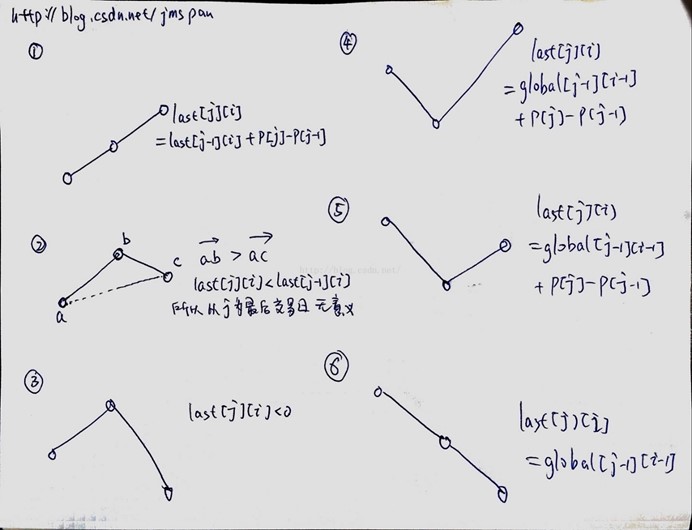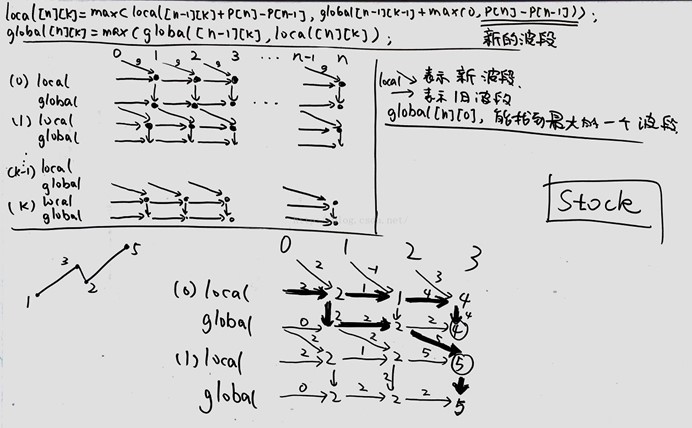买卖股票的最佳时机IV
给定一个数组,它的第 i 个元素是一支给定的股票在第 i 天的价格。
设计一个算法来计算你所能获取的最大利润。你最多可以完成 k 笔交易。
注意: 你不能同时参与多笔交易(你必须在再次购买前出售掉之前的股票)。
示例 1:
输入: [2,4,1], k = 2
输出: 2
解释: 在第 1 天 (股票价格 = 2) 的时候买入,在第 2 天 (股票价格 = 4) 的时候卖出,这笔交易所能获得利润 = 4-2 = 2 。
示例 2:
输入: [3,2,6,5,0,3], k = 2
输出: 7
解释: 在第 2 天 (股票价格 = 2) 的时候买入,在第 3 天 (股票价格 = 6) 的时候卖出, 这笔交易所能获得利润 = 6-2 = 4 。
随后,在第 5 天 (股票价格 = 0) 的时候买入,在第 6 天 (股票价格 = 3) 的时候卖出, 这笔交易所能获得利润 = 3-0 = 3 。
思路:定义两个二维变量,
last[j][i],表示恰好在第j日完成第i次交易的最大收益。
total[j][i],表示在第j日之前(含)完成i次交易的最大收益。
那么如何递归或者递推计算两个变量的值呢?我们先考虑total变量,第j日之前完成i次交易,可以分为两种情况,第一种情况是最后一日不作任何交易,第二种是最后一日完成第i次交易,则total[j][i] = max(total[j-1][i], last[j][i]),这个比较容易理解。如何计算last呢?我们可以按照倒数第二日的交易情况进行分类,分为倒数第二日完成第i次交易,以及倒数第二日不做任何交易。对于前者,我们可以观察如果倒数第二日的第i次交易推迟到第i日的获利情况;对于后者,我们可以观察倒数第二日买入,最后一日(第j日)卖出的情况,即:last[j][i] = max(0, last[j-1][i] + prices[j] - prices[j-1], total[j-1][i-1] + prices[j] - prices[j-1])。为什么会有0呢?因为我们的交易至少不能亏钱,如果一定要有交易的话,我们当天买入、当天卖出,至少是可以不亏的。但会不会有其他情况呢?例如最后一次交易有没有可能是倒数第三天买入,最后一天卖出?分析下面六种情况,可以知道公式是正确的。

数据流演示:

1 public class Solution { 2 private int max(int[] prices) { 3 int max = 0; 4 for(int i=1; i<prices.length; i++) { 5 max += Math.max(0, prices[i] - prices[i-1]); 6 } 7 return max; 8 } 9 public int maxProfit(int k, int[] prices) { 10 if (prices == null || prices.length < 2) return 0; 11 int n = prices.length; 12 if (k >= n/2) return max(prices); 13 int[][] last = new int[n][k+1]; 14 int[][] total = new int[n][k+1]; 15 for(int t = 1; t <= k; t ++) { 16 for(int d = 1; d < n; d ++) { 17 last[d][t] = Math.max(last[d-1][t] + prices[d] - prices[d-1], total[d-1][t-1] + Math.max(0, prices[d] - prices[d-1])); 18 total[d][t] = Math.max(total[d-1][t], last[d][t]); 19 } 20 } 21 return total[n-1][k]; 22 } 23 }